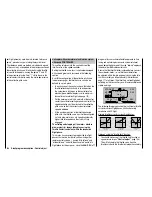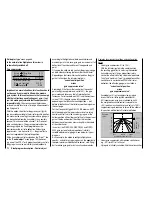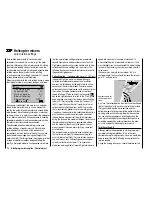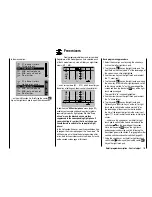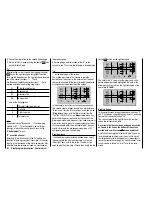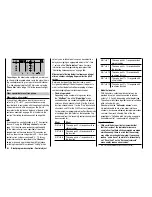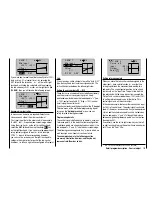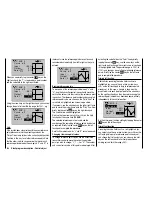
180
Detail program description - Control adjust
General notes on freely programmable mixers
The previous pages have described a wealth of ready-
to-use built-in coupling functions, in the context of the
two menus
"Wing mixers"
and
"Helicopter mixers"
.
The fundamental signifi cance of mixers and the principle
by which they work are described on page 145. The
following section presents you with information relating
to "free mixers".
In addition to the pre-programmed mixers previously
mentioned, the
mx-20
HoTT offers a number of freely
programmable mixers in every model memory, whose
inputs, outputs and mixer ratios can be confi gured to suit
your exact requirements:
8 linear mixers, numbered M1 to M8
•
4 curve mixers, numbered K9 to K12
•
These 12 mixers are certainly adequate for most
applications and are invariably suffi cient when you
incorporate the pre-programmed coupling functions
offered. On the "
Mix active/phase
" menu (see page
192), you are also free to specify which of these
12 mixers is activated or deactivated separately for each
fl ight phase.
For the "free mixers", the signal present at any control
function (1 to 12) can be assigned as the
input signal
.
For the "switch channel" (see further below), the signal
from any switch can be utilized. The signal that is
present at the control channel and passed to the mixer
input is always infl uenced by its own transmitter control
and by any control characteristic that may have been
set, e. g. those specifi ed by the "
Dual Rate / Expo
",
"
Channel 1 curve
" and "
Control adjust
" menus.
The mixer output acts on a
control channel
(1 to 12,
depending on receiver type) that can also be
assigned
freely
. Before this channel routes the signal to the servo,
it can be infl uenced only by the "Servo adjustments"
menu, i.e. by the the servo reverse, neutral point offset,
servo travel and servo travel limit functions, and also
possibly by " Tx. output swap ".
One
control function
can be used for any number of mix
inputs simultaneously: if, for example, several mixers
should be switched to act in parallel.
Conversely, it is possible for any number of mixers to
affect one and the same
control channel
. Particularly in
the latter case, however, it is very important to ensure
that the servo concerned does not strike its mechanical
end-stops when several mixer signals accumulate
to an excessive extent. For safety's sake it may be
worth setting an appropriate travel limit on the "
Servo
adjustments
" menu in such cases.
For more complex applications, mixers can be switched
in sequence. In this case, it is not the (transmitter) signal
at the "output" of a control function which forms the input
signal of the "series-wired" mixer, but the (mixed) signal
"further back" at the "input" of a control channel. The
following description of the free mixers includes several
examples of this type.
In the software, one "free mixer" is always initially
activated. If you wish, however, the mixer can also be
assigned an ON/OFF switch. Since there are so many
functions to which switches can be assigned, you must
be careful to avoid undesirable multiple assignments.
The two key mixer parameters are:
…
•
the mixer ratio
, which defi nes the extent to which
the input signal acts on the output of the control
channel connected to the mixer output.
If you are using linear mixers, the mixer ratio can be
set as symmetrical or asymmetric. Curve mixers can
also be confi gured with up to 6 points to suit your
application, enabling the implementation of highly
non-linear curves.
…
•
the neutral point
of a mixer, which is also
referred to as the "offset".
The offset is the specifi c point along the travel of a
transmitter control (joystick, CTRL 6 … 8 proportional
controls or switches 1 … 9) at which the mixer no
longer infl uences the control channel connected to
its output. Normally, the neutral point is the center
point of the transmitter control. However, the offset
can also be set at any other point along the control
travel. Since there are no restrictions on the design
of the curve mixers, setting a mixer neutral point only
makes sense for the 8 linear mixers.
Switch channel "S" as a mixer input
Occasionally, however, only a constant control signal is
required at the mixer input. A typical application would
be a slightly increased "up-elevator" trim when the aero-
tow release is closed – fully independently of its normal
trim setting.
In this case a switch is assigned both to the aero-tow
release and the mixer; it is then used not only to open
and close the release, but also to pass the desired trim
signal to the elevator via the mixer ratio. To identify this
special arrangement, this mixer input control function in
the program is designated "S" for "Switch channel".
In addition, if the corresponding "target channel" should
now no longer be infl uenced by its "normal" transmitter
control, then you should isolate the latter from the
function input of the affected control channel on the
"MIX-only channel"
menu (page 193). In the menu
description that follows, an example is also given to
illustrate this function.
Using the arrow keys on the left or right touch pad, page
Summary of Contents for mx-20 Hott
Page 41: ...41 Your notes...
Page 49: ...49 Your notes...
Page 55: ...55 Your notes...
Page 81: ...81 Your notes...
Page 85: ...85 Your notes...
Page 89: ...89 Your notes...
Page 99: ...99 Detail program description Control adjust...
Page 127: ...127 Detail program description Control adjust...
Page 131: ...131 Detail program description Control adjust...
Page 163: ...163 Detail program description Control adjust...
Page 191: ...191 Detail program description Control adjust...
Page 207: ...207 Detail program description Control adjust...
Page 228: ...228 Detail program description Control adjust...
Page 229: ...229 Detail program description Control adjust...
Page 251: ...251 Detail program description Control adjust...



